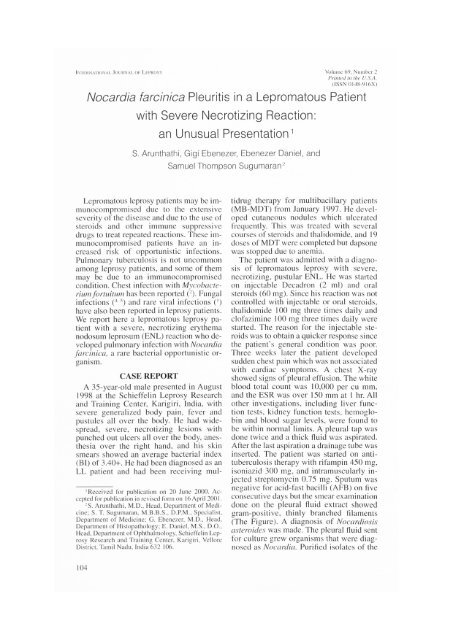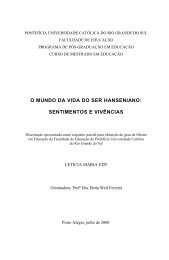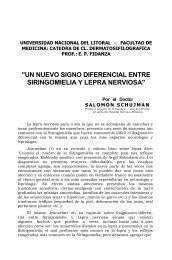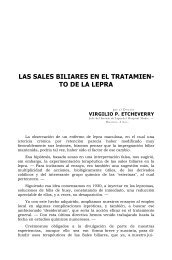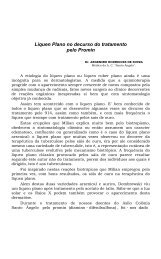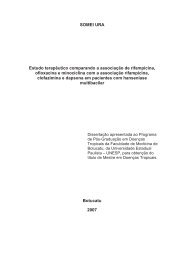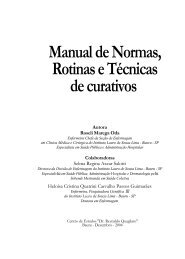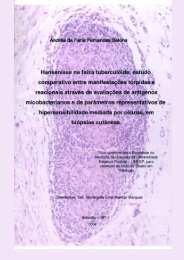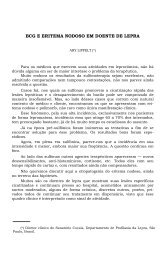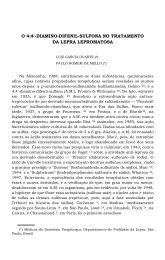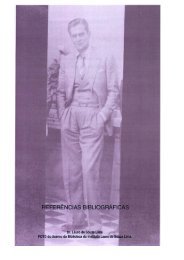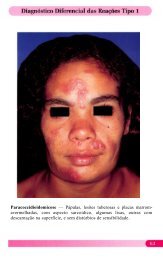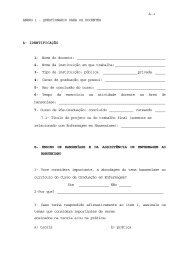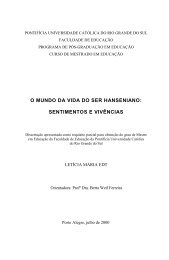Nocardia farcinica Pleuritis in a Lepromatous Patient with ... - Index of
Nocardia farcinica Pleuritis in a Lepromatous Patient with ... - Index of
Nocardia farcinica Pleuritis in a Lepromatous Patient with ... - Index of
Create successful ePaper yourself
Turn your PDF publications into a flip-book with our unique Google optimized e-Paper software.
Volume 69. Number 2<br />
Pr<strong>in</strong>t d <strong>in</strong> ihe U.S.A.<br />
(ISSN 0148 -916X)<br />
<strong>Nocardia</strong> <strong>farc<strong>in</strong>ica</strong> <strong>Pleuritis</strong> <strong>in</strong> a <strong>Lepromatous</strong> <strong>Patient</strong><br />
INTERNATIONAI. JOURNAI. I )1 I.I I 'ROSY ^<br />
<strong>with</strong> Severe Necrotiz<strong>in</strong>g Reaction:<br />
an Unusual Presentation'<br />
S. Arunthathi, Gigi Ebenezer, Ebenezer Daniel, and<br />
<strong>Lepromatous</strong> Ieprosy patients may be immunocompromised<br />
due to the extensive<br />
severity <strong>of</strong> the disease and due to the use <strong>of</strong><br />
steroids and other immune suppressive<br />
drugs to treat repeated reactions. These immunocompromised<br />
patients have an <strong>in</strong>creased<br />
risk <strong>of</strong> opportunistic <strong>in</strong>fections.<br />
Pulmonary tuberculosis is not uncomnnm<br />
among Ieprosy patients, and some <strong>of</strong> them<br />
may be due to an immunocompromised<br />
condition. Chest <strong>in</strong>fection <strong>with</strong> Mycobacteriant<br />
fortadam has been reported ( 2). Fungai<br />
<strong>in</strong>fections ( 4 S) and rare viral <strong>in</strong>fections (' )<br />
have also been reported <strong>in</strong> leprosy patients.<br />
We report here a lepromatous Ieprosy patient<br />
<strong>with</strong> a severe, necrotiz<strong>in</strong>g erythema<br />
nodosum leprosum (ENL) reaction who developed<br />
pulmonary <strong>in</strong>fection <strong>with</strong> Nocarclia<br />
<strong>farc<strong>in</strong>ica</strong>, a rare bacterial opportunistic organism.<br />
CASE REPORT<br />
A 35-year-old mate presented <strong>in</strong> August<br />
1998 at the Schieffel<strong>in</strong> Leprosy Research<br />
and Tra<strong>in</strong><strong>in</strong>g Center, Karigiri, Incha, <strong>with</strong><br />
severe generalized body pa<strong>in</strong>, fever and<br />
pustules ali over the body. He had widespread,<br />
severe, necrotiz<strong>in</strong>g lesions <strong>with</strong><br />
punched out ulcers ali over the body, anesthesia<br />
over the right hand. and his sk<strong>in</strong><br />
smears showed an average bacterial <strong>in</strong>dex<br />
(BI) <strong>of</strong> 3.40+. He had been diagnosed as an<br />
LL patient and had been receiv<strong>in</strong>g mul-<br />
Received for puhlicatiou on 20 .Ione 2000. Accepted<br />
for publication <strong>in</strong> revised form on 16 Aprit 2001.<br />
S. Arunthathi. M.D.. Head. Department <strong>of</strong> Medic<strong>in</strong>e;<br />
S. T. Sugumaran, M.B.B.S., D.P.M., Specialist,<br />
Department <strong>of</strong> Medic<strong>in</strong>e; G. Ebenezer, M.D., Head.<br />
Department <strong>of</strong> Histopathology; E. Daniel, M.S..<br />
Head. Department 01 Ophthalmology, Schicffel<strong>in</strong> Leprosy<br />
Research and Tra<strong>in</strong><strong>in</strong>g Center, Karigiri, Vellore<br />
District, Tamil Nadu, Iniba 632 106.<br />
104<br />
Samuel Thompson Sugumaran''<br />
tidrug therapy for tuultibacillary patients<br />
(MB-MDT) from January 1997. He deveioped<br />
cutaneous nodules which ulcerated<br />
frequently. This was treated <strong>with</strong> several<br />
courses <strong>of</strong> steroids and thalidomide, and 19<br />
doses <strong>of</strong> MDT were completcd but dapsone<br />
was stopped due to anemia.<br />
The patient was admitted <strong>with</strong> a diagnosis<br />
<strong>of</strong> lepromatous Ieprosy <strong>with</strong> severe,<br />
necrotiz<strong>in</strong>g, pustular ENL. He was started<br />
on <strong>in</strong>jectable Decadron (2 ml) and oral<br />
steroids (60 mg). S<strong>in</strong>ce his reaction was not<br />
conirolled <strong>with</strong> <strong>in</strong>jectable or oral steroids,<br />
thalidomide 100 mie three times daily and<br />
cl<strong>of</strong>azim<strong>in</strong>e 100 mg three times daily were<br />
started. The reason for the <strong>in</strong>jectable steroids<br />
was to obta<strong>in</strong> a quicker response l<strong>in</strong>ce<br />
the patient's general condition was poor.<br />
Three weeks later the patient developed<br />
sudden chest pa<strong>in</strong> which was not associated<br />
<strong>with</strong> cardiac symptoms. A chest X-ray<br />
showed signs <strong>of</strong> pleural effusion. The white<br />
blood total count was 10.000 per cu mm.<br />
and the ESR was over 150 mm at 1 hr. Ali<br />
other <strong>in</strong>vestigations, <strong>in</strong>clud<strong>in</strong>g tiver function<br />
tests. kidney function tests, hemoglob<strong>in</strong><br />
and blood sugar leveis, were found to<br />
be <strong>with</strong><strong>in</strong> normal limits. A pleural tal) was<br />
done twice and a thick fluid was aspirated.<br />
After the last aspiration a dra<strong>in</strong>age tube was<br />
<strong>in</strong>serted. The patient was started on antituberculosis<br />
therapy <strong>with</strong> rifamp<strong>in</strong> 450 mg,<br />
isoniazid 300 mg, and <strong>in</strong>tramuscularly <strong>in</strong>jected<br />
streptomyc<strong>in</strong> 0.75 mg. Sputum was<br />
negative for acid-fast bacilli (AFB) on tive<br />
consecutive clays but the smearexam<strong>in</strong>ation<br />
done on the pleural fluid extract showed<br />
Oram-positive, th<strong>in</strong>ly branched filaments<br />
(The Figure). A diagnosis <strong>of</strong> Nocar iosis<br />
asteroides was made. The pleural fluid sent<br />
for culture grew organisms that were diagnosed<br />
as <strong>Nocardia</strong>. Purified isolates <strong>of</strong> the
69, 2^Aranthathi, et al.: N. <strong>farc<strong>in</strong>ica</strong> <strong>Pleuritis</strong>^105<br />
TiHE FIGURE. Oram sta<strong>in</strong> <strong>of</strong> pleural flui(' show<strong>in</strong>g<br />
th<strong>in</strong> beaded filaments (x1000).<br />
organism grown on culture were sent to the<br />
Communicable Disease Center at Atlanta,<br />
Georgia, U.S.A., where they were later<br />
identified as <strong>Nocardia</strong> <strong>farc<strong>in</strong>ica</strong>.<br />
Improvement was <strong>in</strong>terspersed <strong>with</strong> a<br />
number <strong>of</strong> setbacks. Dapsone caused anemia,<br />
for which the patient was given a<br />
blood transfusion. Due to the <strong>in</strong>creased and<br />
prolonged dosage <strong>of</strong> oral and <strong>in</strong>jectable<br />
steroids the patient developed gastritis. Because<br />
<strong>of</strong> this, cl<strong>of</strong>azim<strong>in</strong>e had to be stopped<br />
for a short duration but was added aga<strong>in</strong><br />
when the patient developed an ENL reaction.<br />
Bilateral posterior subcapsular cataract<br />
developed <strong>in</strong> both eyes as a result <strong>of</strong> the<br />
prolonged steroid therapy. In one eye a<br />
cataract extraction was done and postoperatively<br />
there was severe cystoid macular<br />
edema which had to be treated <strong>with</strong> an <strong>in</strong>creased<br />
dosage <strong>of</strong> oral steroids. The olhei -<br />
eye operated on after 7 months did not develop<br />
any postoperative complication. The<br />
patient was treated <strong>with</strong> amikac<strong>in</strong> and crystall<strong>in</strong>e<br />
penicill<strong>in</strong> s<strong>in</strong>ce lhe <strong>Nocardia</strong> species<br />
identified <strong>in</strong> the pleural aspirate was sensitive<br />
to amikac<strong>in</strong>. The patient also received<br />
crystall<strong>in</strong>e penicill<strong>in</strong> s<strong>in</strong>ce pus from the<br />
pleural cavity grew Act<strong>in</strong>omaclurella act<strong>in</strong>onircete.<br />
Sputum culture showed heavy<br />
growth <strong>of</strong> Pse iulontonas aerug<strong>in</strong>osa and<br />
Cana/ida albicans. He also received antituberculosis<br />
treatment. He completed 2<br />
years <strong>of</strong> antileprosy treatment. His reactions<br />
gradually subsided <strong>with</strong> prolonged steroid<br />
and cl<strong>of</strong>azim<strong>in</strong>e treatment. He has not had<br />
any ENL reaction for the past 9 months.<br />
DISCUSSION<br />
The case study is <strong>of</strong> a lepromatous leprosy<br />
patient <strong>with</strong> a high bacterial load who<br />
had been started on MDT. Two months after<br />
MDT was started the patient developed<br />
ENL nodules which ulcerated frequently.<br />
The patient developed pleuritis. Steroids<br />
are known to suppress the natural immune<br />
mechanism. In such a state the patient is at<br />
risk for opportunistic <strong>in</strong>fections. This case<br />
report is presente(' because <strong>of</strong> the diverse<br />
cl<strong>in</strong>icai presentations and the therapeutic<br />
dilemmas that were encountered while<br />
treat<strong>in</strong>g the patient. It is also <strong>of</strong> <strong>in</strong>terest because<br />
<strong>of</strong> the unusual organism cultured<br />
from the pleural fluid.<br />
The aspirated pleural fluid showed th<strong>in</strong>ly<br />
filamented, branch<strong>in</strong>g, fragmente(' grampositive<br />
organisms. Culture showed that the<br />
organisms belonged to the <strong>Nocardia</strong> species<br />
and the type was <strong>in</strong>itially reported as <strong>Nocardia</strong><br />
asteroides. Nocardiosis is an opportunistic<br />
fungai <strong>in</strong>fection usually caused by<br />
<strong>in</strong>fection <strong>with</strong> N. asteroides which is found<br />
<strong>in</strong> soil and water. It is usually found <strong>in</strong> patients<br />
<strong>with</strong> compromised ccIIular immunity.<br />
In Chis patient severe necrotiz<strong>in</strong>g ENL and<br />
large doses <strong>of</strong> immunosuppressive drugs<br />
must have created an environment that was<br />
conducive to the growth <strong>of</strong> <strong>Nocardia</strong>. Less<br />
frequently, nocardiosis is caused by <strong>in</strong>fection<br />
<strong>with</strong> N. brasiliensis or N. otiticliscaniarum.<br />
Infection <strong>with</strong> other species <strong>of</strong> <strong>Nocardia</strong><br />
is very rare. The fungai isolate was<br />
sent for further <strong>in</strong>vestigation to the Communicable<br />
Disease Center at Atlanta and<br />
was identified as N. <strong>farc<strong>in</strong>ica</strong>. N. <strong>farc<strong>in</strong>ica</strong><br />
is a grani-positive, acid-fast pleomorphic<br />
bacillus associated <strong>with</strong> acute and dissem<strong>in</strong>ated<br />
<strong>in</strong>fection. Differentiation <strong>of</strong> N.<br />
<strong>farc<strong>in</strong>ica</strong> from the other members <strong>of</strong> the<br />
N. asleroides complex is important because<br />
<strong>of</strong> lhe high levei <strong>of</strong> antibiotic resistance<br />
associated <strong>with</strong> this species. 111 this LL pa-
106^ International Journal <strong>of</strong> Leprosy^ 200 1<br />
tient, it was found to be resistant to ampicill<strong>in</strong>,<br />
erythromyc<strong>in</strong>, sulfamethaxazoletrimethopr<strong>in</strong>,<br />
cephalex<strong>in</strong>, cephalospor<strong>in</strong> and<br />
vancomyc<strong>in</strong>. It was susceptible to amikac<strong>in</strong><br />
and m<strong>in</strong>ocycl<strong>in</strong>e. N. <strong>farc<strong>in</strong>ica</strong> is identified<br />
rout<strong>in</strong>ely by biochemical and antibiotic susceptibility<br />
pr<strong>of</strong>iles and, alternatively, may<br />
he identified as well as subspeciated by rihotyp<strong>in</strong>g.<br />
When compared <strong>with</strong> other members<br />
<strong>of</strong> the N. asteroides complex isolated<br />
from cl<strong>in</strong>icai specimens, N. <strong>farc<strong>in</strong>ica</strong> exhibits<br />
<strong>in</strong>creased dissem<strong>in</strong>ation, virulence,<br />
and antibiotic resistance ( 7 ")<br />
There is also evidence <strong>of</strong> an <strong>in</strong>creas<strong>in</strong>g <strong>in</strong>cidence<br />
<strong>of</strong> disease caused by N. <strong>farc<strong>in</strong>ica</strong> (`).<br />
N. <strong>farc<strong>in</strong>ica</strong> is differentiated from other members<br />
<strong>of</strong> the N. asteroides complex by equal<br />
growth at 35°C and 45°C, cefotaxime resistance,<br />
acid production from L-rhamnose, and<br />
positive results for one or two additional<br />
tests (hydrolysis <strong>of</strong> acetamide or resistance<br />
to cefamandole and tobramyc<strong>in</strong>). These<br />
tests may take as long as 4 weeks to complete.<br />
N. <strong>farc<strong>in</strong>ica</strong> is also an <strong>in</strong>terest<strong>in</strong>g organism<br />
because it has long been known that<br />
there is serological crossreactivity between<br />
M. leprae and <strong>Nocardia</strong> ( 6).<br />
While he was be<strong>in</strong>g treated <strong>with</strong> frequent<br />
oral and <strong>in</strong>jectable steroids, the patient developed<br />
other complications that are common<br />
<strong>with</strong> prolonged steroid use. The gastritis<br />
needed to be treated <strong>with</strong> an H2 receptor<br />
antagonist and because cl<strong>of</strong>azim<strong>in</strong>e is a<br />
known gastric irritant, this drug had to be<br />
discont<strong>in</strong>ued until the gastritis subsided.<br />
The bilateral, steroid-<strong>in</strong>duced cataracts<br />
which developed had to be treated <strong>with</strong> surgical<br />
removal <strong>of</strong> the lens. In the first eye<br />
which was operated on, the patient developed<br />
severe cystoid macular edema and had<br />
to be treated <strong>with</strong> oral steroids. However,<br />
the other eye, which had an <strong>in</strong>tra-ocular<br />
lens implanted, rema<strong>in</strong>ed quiet <strong>with</strong> good<br />
vision <strong>in</strong> the immediate postoperative period<br />
as well as 7 months later. The outcome<br />
<strong>of</strong> the pulmonary <strong>in</strong>fection has been excellent<br />
<strong>with</strong> considerable radiological clearance.<br />
The patient's general condition has<br />
ietproved; he is reaction free and comes<br />
regularly for follow up.<br />
SUMMARY<br />
A young, male, lepromatous leprosy<br />
patient <strong>with</strong> a severe necrotiz<strong>in</strong>g erythema<br />
nodosum leprosum reaction treated <strong>with</strong><br />
prolonged oral steroids and thalidomide developed<br />
pleuritis that was caused by a rare<br />
opportunistic pathogen, <strong>Nocardia</strong> <strong>farc<strong>in</strong>ica</strong>.<br />
This organism was resistant to most antibiotics<br />
but was susceptible to amikac<strong>in</strong> and<br />
m<strong>in</strong>ocycl<strong>in</strong>e. Dur<strong>in</strong>g the course <strong>of</strong> treatment<br />
the patient developed severe gastritis<br />
which necessitated the removal <strong>of</strong> cl<strong>of</strong>azim<strong>in</strong>e<br />
and the <strong>in</strong>clusion <strong>of</strong> an H2 receptor<br />
antagonist. Bilateral steroid-<strong>in</strong>duced cataracts<br />
needed surgical correction. This case is<br />
be<strong>in</strong>g presented for its rare opportunistic<br />
bacterial <strong>in</strong>fection and for the multiple complications<br />
which made treatment difficult.<br />
RESUMEN<br />
Un joven paciente con lepra lepromatosa, tratado<br />
con esteroides orales y talidomida debido a que presentaba<br />
una grave reacción leprosa tipo critema nodoso<br />
leproso, desarrolló pleuritis causada por <strong>Nocardia</strong><br />
<strong>farc<strong>in</strong>ica</strong>, un raro patógeno oportunista. Este organismo<br />
fue resistente a la mayoría de los antibióticos<br />
pero fue susceptible a la amikac<strong>in</strong>a y a la monocicl<strong>in</strong>a.<br />
Durante el curso del tratamiento. el paciente desarrolló<br />
gastritis severa que ameritó la suspensión de la cl<strong>of</strong>azim<strong>in</strong>a<br />
y la <strong>in</strong>clusión de un antagonista del receptor H2.<br />
Debido al tratamiento esteroidal, el paciente también<br />
desarrolló cataratas bilaterales que requirieron de<br />
tratamiento quirúrgico. Este caso se presenta por la <strong>in</strong>fección<br />
con el raro microorganismo oportunista, y por<br />
Ias múltiples complicaciones que dificultaron el<br />
tratamiento del paciente.<br />
RÉSUMÉ<br />
Un jeune homme, souffrant de lèpra lépromateuse<br />
compliquée d'une sévère réaction nécrosante à type<br />
d'érytheme noueux lépreux. et qui avait été traité de<br />
façon prolongée par voie orate avec des corticoïdes et<br />
la thalidomide, a développé une pleurésic provoquée<br />
par un germe opportuniste rare: <strong>Nocardia</strong> <strong>farc<strong>in</strong>ica</strong>. Ce<br />
germe était résistant à la plupart des antibiotiques,<br />
mais était sensible à l'Amikac<strong>in</strong>e et la M<strong>in</strong>ocycl<strong>in</strong>e.<br />
Pendant le traitement. le patient a présenté une sévère<br />
gastrite, qui a motivé I'arrêt de la Cl<strong>of</strong>azim<strong>in</strong>e et la<br />
prescription d'un antagonista des récepteurs histam<strong>in</strong>iques<br />
de type 2 (112). Une cataracte bilatérale <strong>in</strong>dulte<br />
par les corticoïdes a dü être corrigée chirurgicalement.<br />
La présentation de ce cas cl<strong>in</strong>ique a été motivée<br />
par la description d'une rare sur<strong>in</strong>fection<br />
bactérienne opportuniste et par l'aspect important des<br />
effets secondaires qui ont compliqué le traitement.<br />
Acknowledgment. We acknowledge Dr. Mary<br />
Mathews, Pr<strong>of</strong>essor <strong>of</strong> Microbiology. Christian Medical<br />
College. Vellore, Incha, and Dr. June Brown, Microbiologist,<br />
Centers for Disease Control and Preven-
69, 2^Arr ntthaihi, et ai.: N. <strong>farc<strong>in</strong>ica</strong> <strong>Pleuritis</strong>^ 107<br />
tios, Atlanta, Georgia. U.S.A., for thcir contributions<br />
<strong>in</strong> idem ifv<strong>in</strong>a lhe organism.<br />
REFERENCES<br />
I..Incvh. W. K. and LuctwI:u, W. Epiderniodysplasia<br />
verruciformis <strong>in</strong> lepromatous Ieprusy. Report <strong>of</strong> 2<br />
cases. Dcrmatolugica 168 (1984) 202-205.<br />
2. Kxroc'u, K., K.Tocrt, V. M.. Du r .rn. A. K.,<br />
SIIARMA. V. 11 and RAMO, G. C'hest <strong>in</strong>fection doe<br />
to M. •/QwuiWEn <strong>in</strong> a case <strong>of</strong> lepromatous leprosya<br />
case report. Inchai] .1. Lepr. 57 ( 19$5) 399-403.<br />
McNuu., M. M. and BROwN, J. M. The medically<br />
important aerobic act<strong>in</strong>omycetes: epidemiolugy<br />
and microbiology. Cl<strong>in</strong>. Microbiol. Rev. 7 (1994)<br />
357-417.<br />
4. MEYERS, W. M., DOOLEY, J. R. and KWON-CHUNG,<br />
K. J. Mycotic granulonit caused by Phialophara<br />
repens. Am..1. C<strong>in</strong>. Patim'. 64 (1975) 549-555.<br />
5. PAVITHRAN, K. Chron uoblastomycosis <strong>in</strong> a residual<br />
patch <strong>of</strong> Ieprusy. Indian J. Lepr. 60(1988) 444-447.<br />
6. Ripa . M. Crossreactivity between Mvcobw terimn<br />
lepra(' and various act<strong>in</strong>omyceles and reiated<br />
organisms. Int.J. Lepr. 51 (1983) 185-190.<br />
7. WALLACE, R. J.. JR., BROWN, B. A., BROWN, J. M.<br />
and McNE U., M. M. Taxonomy <strong>of</strong> <strong>Nocardia</strong> species.<br />
Cl<strong>in</strong>. lnfect. Dis. 18 (1994) 476-477.<br />
8. WALLACE, R. J...IR., S ...uuu:. L. C., SUNITER, G. and<br />
SMrrH, J.-M. Atui microbial susceptibility patlerns <strong>of</strong><br />
Nocwrdha asrernkles. Antimicrob. Agents Chemother.<br />
32 ( 1988) 1776-1779.


